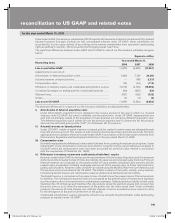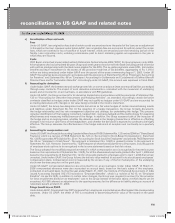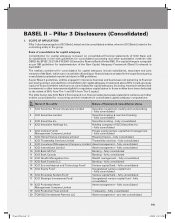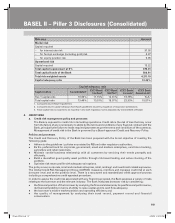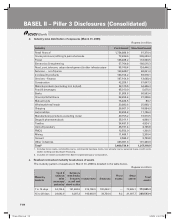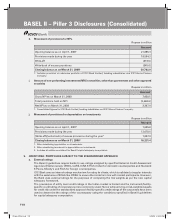ICICI Bank 2008 Annual Report Download - page 169
Download and view the complete annual report
Please find page 169 of the 2008 ICICI Bank annual report below. You can navigate through the pages in the report by either clicking on the pages listed below, or by using the keyword search tool below to find specific information within the annual report.
F95
The quantitative impact on regulatory capital of using risk weighted investments method versus using
the deduction method is set out in the following table:
Rupees in million
Method Quantitative impact
Deduction method 34,989.6
Capital at 9% based on risk weighted assets 3,149.1
2. CAPITAL STRUCTURE
a. Summary information on main terms and conditions / features of capital instruments
RBI’s capital adequacy norms classify capital funds into Tier-1 and Tier-2 capital. Tier-1 capital includes
paid-up equity capital, statutory reserves, other disclosed free reserves, capital reserves and innovative
perpetual debt instruments (Tier-1 bonds) eligible for inclusion in Tier-1 capital that comply with
requirement specified by RBI. Elements of Tier-2 capital include revaluation reserve, general provision
and loss reserve, upper Tier-2 instruments (upper Tier-2 bonds) and subordinate debt instruments (lower
Tier-2 bonds) eligible for inclusion in Tier-2 capital. ICICI Bank and its subsidiaries have issued debt
instruments that form a part of Tier-1 and Tier-2 capital. The terms and conditions that are applicable for
these instruments comply with the stipulated regulatory requirements and where required an independent
legal opinion has been obtained for inclusion of these instruments in capital.
Tier-1 bonds are non-cumulative and perpetual in nature with a call option after 10 years. Interest on
Tier-1 bonds is payable either annually or semi-annually. Some of the Tier-1 bonds have a step-up clause
on interest payment ranging up to 100 bps.
The upper Tier-2 bonds are cumulative and have an original maturity of 15 years with call option after
10 years. The interest on upper Tier-2 bonds is payable either annually or semi-annually. Some of the
upper Tier-2 debt instruments have a step-up clause on interest payment ranging up to 100 bps.
The lower Tier-2 bonds are cumulative and have an original maturity between five to 15 years. The
interest on lower Tier-2 capital instruments is payable quarterly, semi-annually or annually.
b. Amount of Tier-1 capital (March 31, 2008)
Rupees in billion
Tier-1 capital elements Amount
Paid-up share capital/common stock112.82
Reserves2464.11
Innovative Tier-1 capital instruments 26.57
Minority interest 0.50
Gross Tier-1 capital 504.00
Deductions:
Investment in paid-up equity of financial subsidiaries/associates 17.49
Intangible assets other than goodwill321.76
Securitisation exposures including credit enhancements 14.71
Goodwill 0.62
Other deductions 0.28
Minority interest not eligible for inclusion in Tier-1 capital 0.19
Net Tier-1 capital 448.96
1. Includes preference shares permitted by RBI for inclusion in Tier-1 capital.
2. Includes statutory reserves, disclosed free reserves and capital reserves.
3. Includes losses and deferred tax assets and unamortized early retirement options.
BASEL II – Pillar 3 Disclosures (Consolidated)
1P-less_(Pillar).indd 951P-less_(Pillar).indd 95 6/20/08 4:52:28 PM6/20/08 4:52:28 PM






